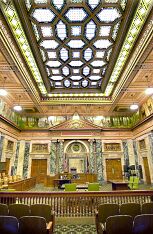Radiating glory
Intricate stained-glass windows put landmark in its best light.
By Carol Tannehill
of The News-Sentinel
 |  |  |  | News-Sentinel photo by Brian Tombaugh
| | Courtroom masterpiecesStained glass like that shown here in Superior Courtroom No. 2 graces the ceiling in each of the four courtrooms on the third floor of the Allen County Courthouse. The creators of the masterpieces are unknown. |
|
|
Amid the massive limestone facades, towering murals, marble staircases and faux marble pillars, the Allen County Courthouse's plentiful stained glass seems especially ethereal. The original skylights and windows add delicate sparkle to a landmark heavy with Beaux-Arts styling and symbolism.
In the late 1800s, the William Andrews Co. of Clinton, Iowa, won the decorative contract for Allen County's fourth courthouse. As it did with much of the courthouse's ornamentation, the company assigned artisans from another firm to create the windows in the rotunda and the skylights in each of four courtrooms.
"What we know about the stained glass is that it came from a subcontractor hired by the contractor," said Elaine Skoog, executive director of the Courthouse Preservation Trust. "We really don't know who actually designed the glass."
Geometric delights
But while the artist or artists may remain forever anonymous, their fragile masterpieces demand attention.
Their works hold their own next to Charles Holloway's celebrated murals in the courthouse's rotunda, which soars several stories to a central dome. Graceful pendentives -- the triangular supports that meet to form arches -- flank four semicircular, jewel-toned stained-glass windows. Within the dome, a circular skylight featuring three concentric glass circles divided into petallike wedges is the interior's crowning glory.
A triptych of stained-glass windows on the east side of the courthouse forms a large semicircle above the sweeping main stairway. The windows' geometric patterns feature repeating squares, each bisected vertically, horizontally and diagonally into eight triangles by dark leading; each square wears a circle of glass in its center. The three panels are flanked by sculpted female figures on the walls. One, carrying a corn stalk, represents the rural county. The other, holding a weaver's distaff, symbolizes the industrialized city.
Ceiling skylights
Each of the four courtrooms on the third floor has a stunning stained-glass skylight gracing its ceiling.
In the Superior Courtroom, the skylight is octagonal with a smaller octagon inside it. Both eight-sided figures are divided into eight wedges with spokes that radiate from their center.
In Superior Courtroom No. 2, the rectangular skylight is surrounded by intricate moldings, square ceiling panels and hanging light fixtures. The stained glass features intertwining hexagons and squares that form large octagons.
Glass octagons linked by smaller glass squares weave an intricate pattern on the rectangular skylight in Superior Courtroom No. 3. Leading or painting adorns the interiors of each eight- and four-side panel.
In the Circuit Courtroom, the stained glass forms a circle within a circle, a pattern reminiscent of the skylight in the rotunda. The larger circle is divided into 12 segments, the smaller into six. Each glass wedge features decorative curlicues, squares and triangles.
Bright -- rain or shine
When the courthouse was finished in 1902, all of the building's art glass shone with natural light, Skoog said. In the evening, it could be lighted electrically.
"Today the skylights in the four courtrooms and in the grand staircase are all lit artificially (even during the day). It is only in the rotunda that the art glass is still lit by natural light," she said.
During World War II, some of the skylights in the roof -- the ones originally intended to backlight the art glass in the rotunda -- were covered. This may have been a precautionary measure in the age of air raids; the courthouse is a government building as well as a landmark. Or, Skoog said, the skylights may have been structurally unsound and leaky.
During the extensive courthouse renovation project, the stained glass was not forgotten.
EverGreene Studios of New York, which led the restoration, delegated the glass work to a subcontractor. Bovard Studios of Fairfield, Iowa, cleaned all and re-leaded some of the stained glass. The painstaking process cost more than $200,000.
The landmark's glorious glass shines like new, but it remains old.
Skoog marvels, "All of the stained glass in the courthouse is still the original."